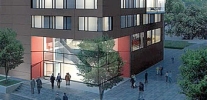




Event Entry
What and Who
Deep High Dynamic Range Imaging: Reconstruction, Generation and Display
Chao Wang
Max-Planck-Institut für Informatik - D4
Promotionskolloquium
AG 1, AG 2, INET, AG 4, AG 5, D6, SWS, RG1
Public Audience
English
Note: We use this to send email in the morning.
Date, Time and Location
Friday, 4 July 2025
12:30
60 Minutes
E1 4
0.19
Saarbrücken
Abstract
High Dynamic Range (HDR) images offer clear advantages over Low Dynamic Range (LDR) images, such as greater bit depth, a wider color gamut, and improved dynamic range, enhancing both visual quality and post-production flexibility. However, challenges remain in HDR content
acquisition and display. This thesis investigates deep learning methods informed by physical priors to address these challenges. It explores HDR
reconstruction from sparse, defocused LDR inputs using implicit neural representations, and extends to HDR all-in-focus field reconstruction
via 3D Gaussian Splatting from multi-view inputs. It further explores HDR generation from in-the-wild LDR images or limited HDR images,
leveraging the learned HDR prior for LDR-to-HDR restoration. Lastly, it proposes a self-supervised tone mapping framework based on feature
contrast masking loss to enable perceptually faithful HDR display on LDR devices.
acquisition and display. This thesis investigates deep learning methods informed by physical priors to address these challenges. It explores HDR
reconstruction from sparse, defocused LDR inputs using implicit neural representations, and extends to HDR all-in-focus field reconstruction
via 3D Gaussian Splatting from multi-view inputs. It further explores HDR generation from in-the-wild LDR images or limited HDR images,
leveraging the learned HDR prior for LDR-to-HDR restoration. Lastly, it proposes a self-supervised tone mapping framework based on feature
contrast masking loss to enable perceptually faithful HDR display on LDR devices.
Contact
Petra Schaaf
+49 681 9325 4000
--email hidden
passcode not visible
logged in users only
Petra Schaaf, 06/26/2025 17:15 -- Created document.